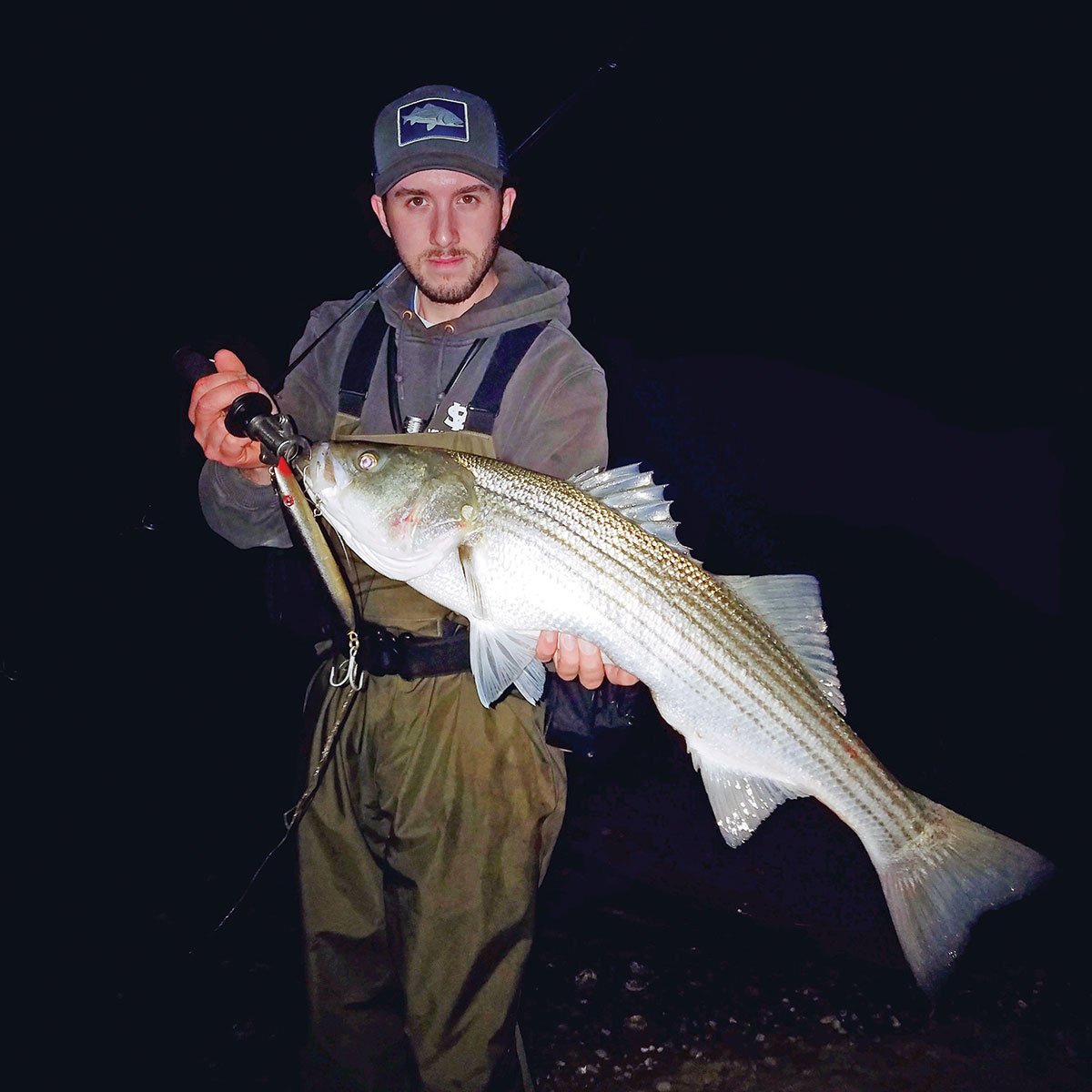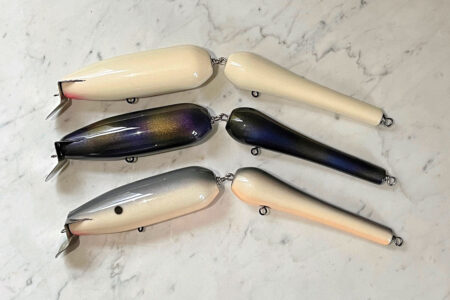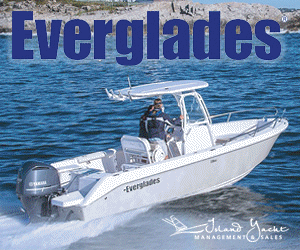
Having confidence in a handful of plugs instead of cramming your bag with dozens of options will lighten your load and cover likely situations.

In today’s surf game all those who venture out are challenged with the thought of what plugs to load into the bag they carry. With the overwhelming amount of plugs, variations of those plugs and colors available to surfcasters today it can make the task quite thought provoking. Years back, I often found myself worrying about not having enough space for all the different plugs and colors that I thought I needed in different situations. Eventually I realized that it’s really a lot simpler than it seems.
These days I only carry a two-tube belt bag with fitted with several bucktail slots for most of my outings. Two tubes to carry all these plugs? No problem at all. I label all of them confidence plugs—lures that have proven themselves season after season, and that I can work with confidence. I can stuff six to 10 plugs, depending on the size of them, into my small bag.
I think at some point all surfcasters should develop a go-to bag where each and every plug is a confidence plug. No second guessing, proven stuff that works for you. What’s in my bag has done well for me over the years, but everyone has had different experiences and everyone’s go-to selection will vary. Also, remember the plugs that I will be talking about are guidelines. I do pull and replace a plug or two depending on where I’m going and the conditions at that particular time. The one thing I ask myself and you should ask yourself when putting a bag together is do I have all the essential plugs in this bag to cover my fishing situations?
Remember everyone’s situations and locations are different so only you, from fishing a spot over time will develop an idea of what will work and what won’t work at those spots. Fine tuning the bag won’t come overnight. It will take several trips to do that.
Minnow Style Plugs

When I use the phrase “minnow style plugs” I’m covering a few different types. The main ones I carry are SP Minnows, Bombers and Mag Darters. The nice thing about all these is they are fairly inexpensive, available in many different colors and easy to use. Typically with these plugs I use them as “fishfinders.” They cover a lot of water and always seem to get fish to strike giving me a true indication of whether or not fish are in the area. A lot of the time they get the smaller fish to strike but a quick swap to a bigger profile will help me target larger fish if that’s what I’m after. Don’t get me wrong though, many times the plugs that normally take smaller fish pull big fish too.
These plugs are all subsurface swimmers with a tight wiggle. The retrieve speed should depend on the current and be varied depending on what the fish want on a given tide. I found that adding a twitch every once in a while entices picky fish trailing the plug to hit it.
Another nice feature about plugs like this is that you don’t need current to fish them. They swim just as effectively in slow moving water or during slack tide. The action depends on your speed of retrieve. I’ve also used these plugs when the current is moving quite fast. They tend to dig pretty well and you will feel them working hard in the current. The key in these situations is to let the current do most of the work. Reel slowly and let them swing through the strike zone.
I know I’m missing a few types that other casters rely on, but these are the ones that have worked for me and earned my confidence. If you have your own preferences, I encourage you to try and incorporate them into your lineup.
Redfins
I didn’t include redfins in the minnow style plug category even though the profile action can be similar to them. They tend to have more of a specific use for me, and the 7-inch version seems to entice some larger fish. Redfins can also be modified to increase casting distance. You can either load them with 10 ccs of mineral oil or BBs to get a desired weight. You should still want the plug to always be floating on the surface when loaded.
As I mentioned, the action of a Redfin is similar to the already talked about plugs. The only difference is that it swims high in the column and pretty much on the surface when retrieved slowly, which separates it from other similar plugs, and makes it a deadly shallow water plug. It is especially deadly when worked over shallow boulder fields. The wiggle a Redfin makes at the surface makes it extremely hard for a bass to pass up. Some of the surface strikes on this plug really get your adrenaline going. A smaller version of this plug is also available. They are a good choice for springtime fishing when bass are feeding on small baits at the surface.
Darters
Ah yes, one of the all-time favorites that has been a proven big fish catcher for decades—darters. These have long been known for their ability to take big fish and that reputation stays true to this day. I will attest to this. Most of my larger fish caught on swimming plugs have fallen to darters. I like to attribute this to the slow, back and forth darting motion that entices larger bass to strike. A darter comes out of my bag in slow to moderate currents. Make your cast uptide, reel up the slack and take a few hard cranks to ensure that the plug digs into the water. Proceed with a slow steady retrieve. Sometimes the slower the better. Let the current swing your plug if possible. Mainly when fishing a darter I rely on a straight retrieve but occasionally I throw in a hard crank, which darts the plug hard one direction and may cause a picky bass trailing the plug to strike.

Another nice thing about fishing darters is they mimic a variety of different baits. I’ve used them when bass were on bunker, squid, herring, weakfish, and mullet. Of course, I change the color up if need be but the darter was universal enough to where it got me strikes during these scenarios.
One other question I get a lot from people is wood or plastic? The benefits that wood seems to have over plastic are wood is available in several different weights and profiles. Wood also seems to dig a little more in current. Plastic on the other hand, is a bit limited when it comes to sizes but the nice thing about plastic is every single plug is the same. Same motion, same action. Unfortunately, I’ve had a couple of wood plugs that were duds that didn’t swim right out of the package. Also, after catching a number of fish on wood they tend to swell with water. Wood lacks the durability of plastic, and plastic most definitely has the edge in my opinion. The reliability factor alone is a major selling point for me.
Bottle Plugs
Certain conditions call for the right plug choice, and when the tide is ripping or there is a big surf up, the bottle plug is the right choice. The unique face design of the bottle plug allows it to hold steady in heavy current when other plugs such as a darter tumbles over itself. I use a bottle plug in the same situations as a darter with increased current speed. They offer a different action than a standard darter. Bottles swim more like a minnow style plug. You will know the plug is working correctly if you feel a heavy pulsating in the rod. If you don’t feel this, the plug may not be dug in or the current might not be running hard enough to use the plug. At that point you may want to throw a darter or minnow plug back on.
The same ideas apply with these. Wood offers some benefits but the reliability of the plastic can’t be matched. The larger profile on the bottles mimics almost any larger bait in the surf. They can even be fished on the beach when you have a strong sweep. Cast uptide like a darter. Dig the plug in and then let the sweep swing the plug through the strike zone.
Needlefish

I used to hear all this talk about needlefish landing big fish over the years and I would throw them once in a while with limited success. During last fall’s sand eel run Long Island’s South Shore, I was determined to utilize this lure in my arsenal and figure it out. The one thing with throwing a needlefish is the lack of excitement when the fish aren’t biting. It pretty much feels li
ke reeling a stick through the water. No real indication that the plug is doing its job. This is why it’s important to carry a few different sized needlefish in the bag when fishing them. Different weights and profiles make a big difference when using them. From what I’ve experienced, I found that using a weight that brings the lure close to the bottom works best. You want a steady slow retrieve and if you have some current let the needlefish swing in it. Always keep tight with the lure and wait for the sharp hit.
I remember one specific night last fall when me and a buddy were working SP Minnows and Mag Darters all night for a slow pick. I pulled out a Super Strike Needlefish and fired a cast uptide. As soon as it swung straight with me I got whacked and was in. I landed a few more bass and he proceeded to switch to one also. We had them almost every cast that night until the tide died off. This was one of those times where I can clearly say the needlefish was what they wanted and made a big difference.
Color
I’ve touched upon the go-to plugs for me but the question that always precedes this is what colors to select with these lures. People can go crazy with all the colors available today. My simple and plain advice is to stick to the basics. Don’t worry about having every different color. Focus on a few and gain confidence in them. For me these are yellow, white, green, blue and blurple. I’ve had great success with all of these and never felt I was at much of a disadvantage because of the limited colors I choose to fish. I try to start out by using lighter colors on bright nights and darker colors on dark nights. I’ll make a switch if this isn’t working for me. I have proven this general rule wrong many times so don’t feel pressured to stick to it.
This fall, lean on those plugs that you have the most confidence in, instead of a bag full of “just in case” lures. You will probably catch more fish, and your back and shoulder will certainly appreciate it.




